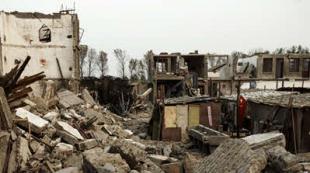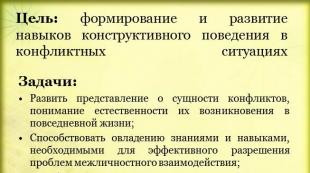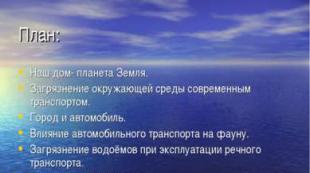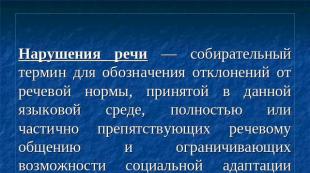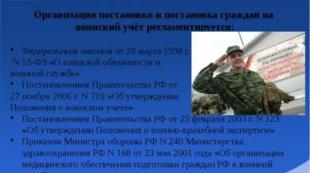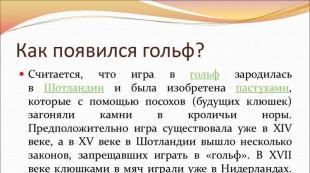Presentation on the topic of radioactivity. Presentation on obzh on the topic "natural radioactivity". Types of radioactive radiation
slide 1
Radioactivity 1) Discovery of radioactivity. 2) The nature of radioactive radiation 3) Radioactive transformations. 4) Isotopes.slide 2
 Studying the effect of luminescent substances on photographic film, the French physicist Antoine Becquerel discovered an unknown radiation. He developed a photographic plate, on which in the dark for some time there was a copper cross covered with uranium salt. The photographic plate produced an image in the form of a distinct shadow of a cross. This meant that uranium salt spontaneously radiates. Becquerel was awarded the Nobel Prize in 1903 for his discovery of the phenomenon of natural radioactivity.
Studying the effect of luminescent substances on photographic film, the French physicist Antoine Becquerel discovered an unknown radiation. He developed a photographic plate, on which in the dark for some time there was a copper cross covered with uranium salt. The photographic plate produced an image in the form of a distinct shadow of a cross. This meant that uranium salt spontaneously radiates. Becquerel was awarded the Nobel Prize in 1903 for his discovery of the phenomenon of natural radioactivity.
slide 3
 RADIOACTIVITY is the ability of some atomic nuclei to spontaneously transform into other nuclei, while emitting various particles: Any spontaneous radioactive decay is exothermic, that is, it occurs with the release of heat. ALPHA PARTICLE (a-particle) - the nucleus of the helium atom. Contains two protons and two neutrons. The emission of a-particles is accompanied by one of the radioactive transformations (alpha decay of nuclei) of certain chemical elements. BETA PARTICLE - An electron emitted during beta decay. The flux of beta particles is one of the types of radioactive radiation with a penetrating power greater than that of alpha particles, but less than that of gamma radiation. GAMMA RADIATION (gamma quanta) - short-wave electromagnetic radiation with a wavelength of less than 2 × 10–10 m. Due to the short wavelength, the wave properties of gamma radiation are weak, and corpuscular properties come to the fore, and therefore its represent in the form of a stream of gamma quanta (photons).
RADIOACTIVITY is the ability of some atomic nuclei to spontaneously transform into other nuclei, while emitting various particles: Any spontaneous radioactive decay is exothermic, that is, it occurs with the release of heat. ALPHA PARTICLE (a-particle) - the nucleus of the helium atom. Contains two protons and two neutrons. The emission of a-particles is accompanied by one of the radioactive transformations (alpha decay of nuclei) of certain chemical elements. BETA PARTICLE - An electron emitted during beta decay. The flux of beta particles is one of the types of radioactive radiation with a penetrating power greater than that of alpha particles, but less than that of gamma radiation. GAMMA RADIATION (gamma quanta) - short-wave electromagnetic radiation with a wavelength of less than 2 × 10–10 m. Due to the short wavelength, the wave properties of gamma radiation are weak, and corpuscular properties come to the fore, and therefore its represent in the form of a stream of gamma quanta (photons).
slide 4

slide 5
 The time it takes for half of the initial number of radioactive atoms to decay is called the half-life.
The time it takes for half of the initial number of radioactive atoms to decay is called the half-life.
slide 6
 Isotopes are varieties of a given chemical element that differ in the mass number of their nuclei. The nuclei of isotopes of the same element contain the same number of protons, but a different number of neutrons. Having the same structure of electron shells, isotopes have almost the same chemical properties. However, the physical properties of isotopes can differ quite sharply.
Isotopes are varieties of a given chemical element that differ in the mass number of their nuclei. The nuclei of isotopes of the same element contain the same number of protons, but a different number of neutrons. Having the same structure of electron shells, isotopes have almost the same chemical properties. However, the physical properties of isotopes can differ quite sharply.
RADIOACTIVITY physics lesson Grade 11
slide 2
RADIOACTIVITY
slide 3
The discovery of X-rays gave impetus to new research. Their study led to new discoveries, one of which was the discovery of radioactivity. Approximately from the middle of the 19th century, experimental facts began to appear that cast doubt on the idea of the indivisibility of atoms. The results of these experiments suggested that atoms have a complex structure and that they contain electrically charged particles. The most striking evidence of the complex structure of the atom was the discovery of the phenomenon of radioactivity, made by the French physicist Henri Becquerel in 1896.
slide 4
Uranium, thorium and some other elements have the property of continuously and without any external influences (i.e. under the influence of internal causes) to emit invisible radiation, which, like X-rays, is able to penetrate through opaque screens and have a photographic and ionization effect. The property of spontaneous emission of such radiation is called radioactivity.
slide 5
Radioactivity was the privilege of the heaviest elements of the periodic system of D.I. Mendeleev. Among the elements contained in the earth's crust, all are radioactive, with serial numbers over 83, i.e., located in the periodic table after bismuth.
slide 6
In 1898, French scientists Marie Skłodowska-Curie and Pierre Curie isolated two new substances from the uranium mineral, much more radioactive than uranium and thorium. Thus, two previously unknown radioactive elements, polonium and radium, were discovered.
Slide 7
Scientists came to the conclusion that radioactivity is a spontaneous process that occurs in the atoms of radioactive elements. Now this phenomenon is defined as the spontaneous transformation of an unstable isotope of one chemical element into an isotope of another element; in this case, electrons, protons, neutrons or helium nuclei (α-particles) are emitted.
Slide 8
Marie and Pierre Curie in the laboratory of THE CURIE'S WIFE In 10 years of joint work, they have done a lot to study the phenomenon of radioactivity. It was selfless work in the name of science - in a poorly equipped laboratory and in the absence of the necessary funds.
Slide 9
Diploma of Nobel Prize winners awarded to Pierre and Marie Curie In 1903, the Curies and A. Becquerel were awarded the Nobel Prize in Physics for discoveries in the field of radioactivity.
Slide 10
After the discovery of radioactive elements, research began on the physical nature of their radiation. In addition to Becquerel and the Curies, Rutherford did this. In 1898, Rutherford began to study the phenomenon of radioactivity. His first fundamental discovery in this area was the discovery of the inhomogeneity of the radiation emitted by radium.
slide 11
Rutherford's experience
slide 12
Types of radioactive radiation a-rays - rays b- rays
slide 13
- particle - the nucleus of a helium atom. -rays have the least penetrating power. A layer of paper about 0.1 mm thick is no longer transparent to them. Weakly deviate in a magnetic field. The particle has two atomic mass units for each of its two elementary charges. Rutherford proved that helium is formed during radioactive a-decay.
Slide 14
β - particles are electrons moving at speeds very close to the speed of light. They deviate strongly in both magnetic and electric fields. β - rays are much less absorbed when passing through matter. An aluminum plate completely delays them only with a thickness of a few millimeters.
slide 15
- rays are electromagnetic waves. In their properties, they are very much like X-rays, but only their penetrating power is much greater than that of X-rays. Not deflected by magnetic field. They have the highest penetrating power. A layer of lead 1 cm thick is not an insurmountable barrier for them. When - rays pass through such a layer of lead, their intensity decreases only by half.
slide 16
Emitting α - and - radiation, the atoms of a radioactive element change, turning into atoms of a new element. In this sense, the emission of radioactive radiation is called radioactive decay. The rules that indicate the displacement of an element in the periodic table due to decay are called displacement rules.
Slide 17
Types of radioactive decay a-decay -decay b-decay
Slide 18
- decay is the spontaneous decay of an atomic nucleus into - a particle (the nucleus of a helium atom) and a product nucleus. The a-decay product turns out to be shifted by two cells to the beginning of the periodic system of Mendeleev.
Slide 19
- decay is the spontaneous transformation of an atomic nucleus by emitting an electron. The nucleus - a product of beta decay turns out to be the nucleus of one of the isotopes of an element with a serial number in the periodic table one greater than the serial number of the original nucleus.
Slide 20
- radiation is not accompanied by a change in charge; the mass of the nucleus changes negligibly little.
slide 21
Radioactive decay Radioactive decay is a radioactive (spontaneous) transformation of the original (parent) nucleus into new (daughter) nuclei. For each radioactive substance, there is a certain time interval during which the activity decreases by half.
slide 22
The law of radioactive decay The half-life T is the time during which half of the available number of radioactive atoms decays. N0 is the number of radioactive atoms at the initial moment of time. N is the number of undecayed atoms at any given time.
slide 23
Used Books:
G.Ya. Myakishev, B.B. Bukhovtsev Physics: a textbook for the 11th grade of educational institutions. - M .: Education, 2000 A.V. Peryshkin, E.M. Gutnik Physics: a textbook for the 9th grade of educational institutions. – M.: Bustard, 2004 E. Curie Marie Curie. - Moscow, Atomizdat, 1973
View all slides
Class: 11
Presentation for the lesson



















 Back forward
Back forward
Attention! The slide preview is for informational purposes only and may not represent the full extent of the presentation. If you are interested in this work, please download the full version.
Lesson type: lesson learning new material
Lesson Objectives: introduce and consolidate the concepts of radioactivity, alpha, beta, gamma radiation and half-life; study the displacement rule and the law of radioactive decay.
Lesson objectives:
a) educational tasks - to explain and consolidate new material, to introduce the history of the discovery of the phenomenon of radioactivity;
b) developmental tasks - to activate the mental activity of students in the classroom, to realize the successful mastery of new material, to develop speech, the ability to draw conclusions;
c) educational tasks - to interest and captivate the topic of the lesson, create a personal situation of success, conduct a collective search to collect material about radiation, create conditions for the development of the ability to structure information in schoolchildren.
During the classes
Teacher:
Guys, I suggest you complete the following task. Find in the list words denoting phenomena: ion, atom, proton, electrization, neutron, conductor, tension, electricity, dielectric, electroscope, grounding, field, optics, lens, resistance, voltage, voltmeter, ammeter, charge, power, lighting, radioactivity, magnet, generator, telegraph, compass, magnetization. Slide number 1.
Define these phenomena. For what phenomenon can we not yet give a definition? That's right, for radioactivity. Slide number 2.
- Guys, the topic of our lesson is radioactivity.
In the previous lesson, some students were given the task of preparing reports on the biographies of scientists: Henri Becquerel, Pierre Curie, Marie Sklodowska-Curie, Ernest Rutherford. Guys, what do you think, is it by chance that these scientists should be discussed today? Maybe some of you already know something about the fate and scientific achievements of these people?
Children offer their own answers.
Well done, you are very knowledgeable! And now let's listen to the material of the speakers.
Children talk about scientists Application No. 1 about A. Becquerel, Application №2 about M. Sklodowska-Curie, Application №3 about P. Curie) and show slides No. 3 (about A. Becquerel), No. 4 (about M. Sklodovskaya-Curie), No. 5 (about P. Curie).
Teacher:
- A hundred years ago, in February 1896, the French physicist Henri Becquerel discovered the spontaneous emission of uranium salts 238 U, but he did not understand the nature of this radiation.
In 1898, the spouses Pierre and Marie Curie discovered new, previously unknown elements - polonium 209 Po and radium 226 Ra, whose radiation, similar to that of uranium, was much stronger. Radium is a rare element; to obtain 1 gram of pure radium, it is necessary to process at least 5 tons of uranium ore; its radioactivity is several million times higher than that of uranium. Slide number 6.
Spontaneous emission of some chemical elements was named at the suggestion of P. Curie radioactivity, from the Latin radio "to radiate". Unstable nuclei are transformed into stable ones. Slide number 7.
Chemical elements with number 83 are radioactive, that is, they spontaneously emit, and the degree of radiation does not depend on which compound they are part of. Slide number 8.
The great physicist of the early 20th century, Ernest Rutherford, studied the nature of radioactive radiation. Guys, let's listen to the message about the biography of E. Rutherford. Application No. 4, Slide number 9.
What is radioactive radiation? I offer you independent work with the text: page 222 of the textbook F-11 by L.E. Gendenshtein and Yu.I. Dik.
Guys, answer the questions:
1. What are α-rays? (α-rays are a stream of particles representing helium nuclei.)
2. What are β-rays? (β-rays are a stream of electrons whose speed is close to the speed of light in a vacuum.)
3. What is γ-radiation? (γ radiation is electromagnetic radiation whose frequency exceeds that of X-rays.)
So (Slide No. 10), in 1899 Ernest Rutherford discovered the inhomogeneity of radiation. Investigating the radiation of radium in a magnetic field, he discovered that the flow of radioactive radiation has a complex structure: it consists of three independent flows, called α-, β- and γ-rays. In further studies, it turned out that α-rays are streams of nuclei of helium atoms, β-rays are streams of fast electrons, and γ-rays are electromagnetic waves with a small wavelength.
But these streams also differed in their penetrating abilities. Slides №11,12.
The transformation of atomic nuclei is often accompanied by the emission of α-, β-rays. If one of the products of radioactive transformation is the nucleus of a helium atom, then such a reaction is called α-decay, if it is an electron, then β-decay.
These two decays obey the displacement rules, which were first formulated by the English scientist F. Soddy. Let's see what these reactions look like.
Slides #13 and #14 respectively:
1. During α-decay, the nucleus loses its positive charge 2e and its mass decreases by 4 a.m.u. As a result of α-decay, the element is shifted two cells to the beginning of the periodic system of Mendeleev:
![]()
2. During β-decay, an electron flies out of the nucleus, which increases the charge of the nucleus by 1e, while the mass remains almost unchanged. As a result of β-decay, the element is shifted one cell to the end of the periodic table of Mendeleev.
![]()
In addition to alpha and beta decays, radioactivity is accompanied by gamma radiation. In this case, a photon flies out of the nucleus. Slide number 15.
3. γ-radiation - not accompanied by a change in charge; the mass of the nucleus changes negligibly little.
Let's try to solve problems for writing nuclear reactions: №20.10; No. 20.12; No. 20.13 from the collection of assignments and independent works by L.A. Kirik, Yu.I. Dick.
- Nuclei that arose as a result of radioactive decay, in turn, can also be radioactive. There is a chain of radioactive transformations. The nuclei associated with this chain form a radioactive series or a radioactive family. There are three radioactive families in nature: uranium, thorium and actinium. The uranium family ends with lead. By measuring the amount of lead in uranium ore, the age of that ore can be determined.
Rutherford empirically established that the activity of radioactive substances decreases with time. For each radioactive substance there is a time interval during which the activity decreases by 2 times. This time is called the half-life T.
What does the law of radioactive decay look like? Slide number 16.
The law of radioactive decay was established by F. Soddy. The formula is used to find the number of undecayed atoms at any given time. Let at the initial moment of time the number of radioactive atoms N 0 . After the half-life they will be N 0 /2. After t = nT there will be N 0 /2 p.
The half-life is the main quantity that determines the rate of radioactive decay. The shorter the half-life, the less time the atoms live, the faster the decay occurs. For different substances, the half-life has different values. Slide number 17.
Both rapidly and slowly decaying nuclei are equally dangerous. Rapidly decaying nuclei emit intense radiation over a short period of time, while slowly decaying nuclei are radioactive over a long time interval. Humanity encounters various levels of radiation both in natural conditions and in artificially created circumstances. slide number 18.
Radioactivity has both negative and positive implications for all life on planet Earth. Guys, let's watch a short movie about the significance of radiation for life. Slide number 19.
And in conclusion of our lesson, let's solve the problem of finding the half-life. Slide number 20.
Homework:
- §31 according to the textbook by L.E. Gendenstein and Yu.I. Dick, f-11;
- s/r No. 21 (n.o.), s/r No. 22 (n.o.) according to the collection of tasks by Kirik L.A. and Dick Yu.I., f-11.
Methodological support
1. L.A. Kirik, Yu.I. Dick, Methodical materials, Physics - 11, publishing house "ILEKSA";
2. E.Gendenstein, Yu.I. Dick, Physics - 11, ILEKSA publishing house;
3. L.A. Kirik, Yu.I. Dick, Collection of assignments and independent work for grade 11, publishing house "ILEKSA";
4. CD with electronic application "ILEKSA", publishing house "ILEKSA".
Radioactivity is a phenomenon of spontaneous transformation of unstable
nuclei
in
sustainable,
accompanied
emission of particles and emission of energy.
Kuchiev Felix RT-11
1
Antoine Henri Becquerel
Imagephotographic plates
becquerel
In 1896, Becquerel accidentally discovered
radioactivity
in
time
works
on
study of phosphorescence in uranium salts.
Examining the work of Roentgen, he turned
fluorescent material - dropped sulfate
potassium
into an opaque material along with
photographic plates in order to prepare for
experiment requiring bright sunlight
Sveta.
However
yet
before
implementation
experiment
becquerel
discovered
what
photographic plates were completely exposed. it
discovery prompted Becquerel to investigate
spontaneous emission of nuclear radiation.
AT
1903
year
he
received
jointly
with Pierre and Marie Curie Nobel Prize
in Physics "In recognition of his outstanding
merit,
expressed
in
opening
spontaneous radioactivity"
2Pierre Curie
Marie Curie
*In 1898 Marie and Pierre Curie discovered
radium
3
Types of radioactive radiation
*Natural radioactivity;*Artificial radioactivity.
Properties of radioactive radiation
* Ionize the air;
*Act on a photographic plate;
* Cause the glow of certain substances;
*Penetrate through thin metal plates;
*Radiation intensity is proportional to
substance concentration;
*The radiation intensity does not depend on external
factors (pressure, temperature, light,
electrical discharges).
4
Penetrating power of radioactive radiation
5* emitted: two protons and two neutrons* penetration: low
* Irradiation from source: up to 10 cm
* radiation speed: 20,000 km/s
* ionization: 30,000 pairs of ions per 1 cm of run
* biological effect of radiation: high
Alpha radiation is the radiation of heavy,
positively charged alpha particles
are the nuclei of helium atoms (two neutrons and two
proton). Alpha particles are emitted when more than
complex nuclei, for example, during the decay of uranium atoms,
radium, thorium.
6
beta radiation
* emitted: electrons or positrons* penetration: medium
* Irradiation from source: up to 20 m
* ionization: from 40 to 150 pairs of ions per 1 cm
mileage
* biological effect of radiation: medium
Beta (β) radiation occurs when one
element to another, while the processes occur in
the very nucleus of an atom of matter with a change in properties
protons and neutrons.
7
Gamma radiation
* emitted: energy in the form of photons* penetration: high
* Irradiation from source: up to hundreds of meters
* radiation speed: 300,000 km/s
* ionization: from 3 to 5 pairs of ions per 1 cm
mileage
* biological effect of radiation: low
Gamma (γ) radiation is an energetic electromagnetic
radiation in the form of photons.
8
radioactive transformations
9Elementary particles
Joseph John ThomsonErnest Rutherford
James Chadwick
Discovered the electron
Discovered the proton
Discovered the neutron
10
Since 1932 More than 400 elementary particles were discovered
An elementary particle is a micro-object thatcannot be divided into parts, but may have
internal structure.
11
Quantities characterizing elementary particles
*Weight.*Electric charge.
*Lifetime.
12In 1931 English
physicist P. Dirac
in theory
predicted
Existence
positron - antiparticle
electron.
13In 1932 the positron was
experimentally opened
American physicist
Carl Anderson.
In 1955, an antiproton, and in 1956
antineutron.
14ELECTRON - POSITRON PAIR
arises when a γ-quantum interacts with
substance.
γ→
e
+
+

Radioactivity -
Opening - 1896
- phenomenon of spontaneous transformation
unstable nuclei into stable ones,
accompanied by emission
particles and energy radiation.

Radioactivity research
All chemical elements
starting from number 83 ,
have radioactivity
1898 -
polonium and radium discovered

Nature radioactive radiation
speed up to 1000000km/s

Types of radioactive radiation
- Natural radioactivity;
- artificial radioactivity.
Properties of radioactive radiation
- Ionize the air;
- Act on a photographic plate;
- Cause the glow of certain substances;
- Penetrate through thin metal plates;
- The radiation intensity is proportional to
substance concentration;
- The radiation intensity does not depend on external factors (pressure, temperature, illumination, electrical discharges).






Protection against radioactive
radiation
Neutrons – water, concrete, earth (substances with a low atomic number)
X-rays, gamma rays –
cast iron, steel, lead, barite brick, lead glass (elements with high atomic number and high density)

radioactive transformations
Displacement rule

isotopes
1911, F. Soddy
There are kernels
the same chemical element
with the same number of protons
but different numbers of neutrons are isotopes.
Isotopes have the same
Chemical properties
(due to the charge of the nucleus),
but different physical properties
(due to mass).


Law of radioactive decay
Half life T –
time interval
during which activity
radioactive element
decreases twice.





Radioactivity around us (according to Zelenkov A.G.)

Methods for registering ionizing radiation
Absorbed dose of radiation -
The energy ratio of the ionizing
Radiation absorbed by matter
to the mass of this substance.
1 Gy = 1 J/kg
Natural background per person 0.002 Gy/year;
PDN 0.05 Gy/year or 0.001 Gy/week;
Lethal dose 3-10 Gy in a short time

Scintillation counter
In 1903, W. Crooks
noticed that the particles
emitted by radioactive
substance, falling on
sulphurous
zinc screen, causes
his glow.
SCREEN
The device was used by E. Rutherford.
Now scintillations are observed and counted
using special devices.

Geiger counter
In a tube filled with argon, a flying
through the gas, the particle ionizes it,
closing the circuit between cathode and anode
and creating a voltage pulse across the resistor.

cloud chamber
1912
The chamber is filled with a mixture of argon and nitrogen with saturated
steam of water or alcohol. Expanding the gas with a piston
supercool the vapor. flying particle
ionizes gas atoms on which steam condenses,
creating a drip trail (track).

bubble chamber
1952
D. Glaser designed a chamber in which you can
Investigate particles with more energy than in the chamber
Wilson. Chamber filled with rapidly boiling liquid
liquefied propane, hydrogen). In a superheated liquid
the particle under study leaves a track of vapor bubbles.

spark chamber
Invented in 1957. Filled with inert gas.
Plano-parallel plates are closely spaced
to each other. High voltage is applied to the plates.
During the passage of a particle along its trajectory, they skip
sparks, creating a fiery track.

Thick film emulsions
flying through
emulsion charged
the particle acts on
bromide grains
silver and forms
hidden image.
When manifested
photographic plates are formed
track - track.
Benefits: traces
do not disappear with time
and can be carefully
studied.
Method developed
In 1958
Zhdanov A.P. and
Mysovsky L.V.

Obtaining radioactive isotopes
Get radioactive isotopes
in nuclear reactors and accelerators
elementary particles.
With the help of nuclear reactions,
get radioactive isotopes
all chemical elements
existing in nature only
in stable condition.
Elements numbered 43, 61, 85 and 87
They do not have stable isotopes at all.
And for the first time they were obtained artificially.
With the help of nuclear reactions obtained
transuranic elements,
starting with neptunium and plutonium
( Z=93 - Z=108)

The use of radioactive isotopes
Labeled atoms: Chemical properties
Radioactive isotopes do not differ
from the properties of non-radioactive isotopes of those
the same elements. Detect radioactive
isotopes can be identified by their emission.
Apply: in medicine, biology,
criminalistics, archaeology,
industry, agriculture.



